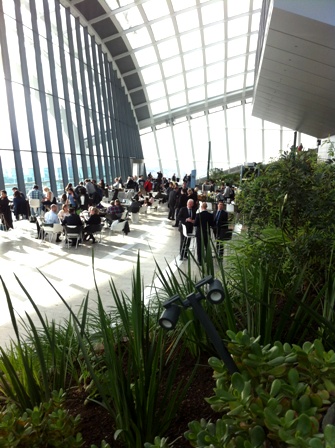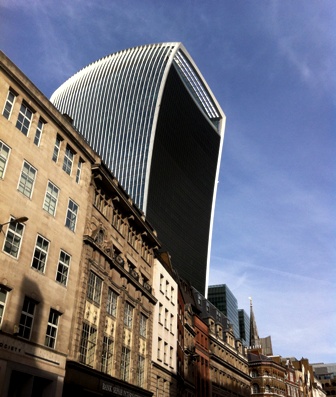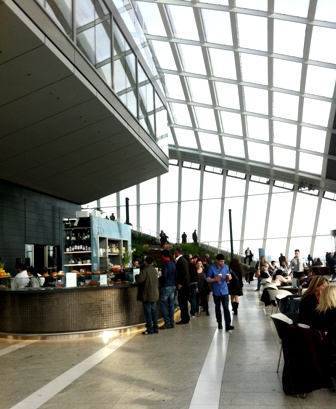
On high: the elevated atmosphere of 20 Fenchurch Street's top floor
Sky-high: a modern vision of open space
When is a park not a park? And how public does a space have to be before it qualifies as public open space? And do you really have to let people in? Or build it at all? The Leisure Review visits London’s most elevated bit of greenery.

On high: the elevated atmosphere of 20 Fenchurch Street's top floor
This may be London’s golden age of high-rise. New towers have changed the capital’s skyline, creating new landmarks and new controversies along the way. The Shard and the ‘Walkie Talkie’ have made it to completion but trade reports suggest that there are another 200 towers on the drawing boards of designers or the desks of planning officers ready to make their mark on the city if given the green light.
Among all this glass, steel and concrete it seems that there is still space for the park; or at least the essence of park. For some developers it has become an essential element of their grand-scale projects. Many schemes offer the promise of public access to their high-profile buildings as a lure to planning authorities beset by objections. Both the Shard and the Walkie Talkie have demonstrated the efficacy of ‘letting the public in’ and this approach seems to be in vogue, even if public access does not always survive the journey from concept to completion.
Having hit upon the idea of the building-based public open space, architects and planners have had to wrestle over every aspect, over every word, of the concept. How public is public? How open is open? How much space qualifies as space? Most importantly, just how much leeway does the notion of public open space deliver when it comes to the planning regulations?
For a number of reasons the attention of the Leisure Review is drawn to 20 Fenchurch Street, now forever known as the Walkie Talkie, just as the Millennium Bridge will be perpetually Wobbly. First, the Sky Garden (“the UK’s tallest [sic] public park”), which occupies the top three floors of the building, was an essential element of planning consent that allowed the building to be built outside the prescribed Leadenhall Street development area. Second, access to the public space is free, at least in the sense that no payment is required; you do have to book tickets in advance but you can savour the knowledge that the Shard charges almost 30 quid while you click. Third, 20 Fenchurch Street and the Leisure Review have some history. For a couple of brief periods a very long time ago your correspondent occupied a desk on the seventh floor of the old building; such geographical attachments are hard to shake.
The old building was not particularly striking but it had a certain elegance, a crisp restraint in its square, glass-walled symmetry that meant it fitted its surroundings (at least vertically; away from the main entrance at ground level it was an ill-conceived mess of car parking and loading bays). For many years it stood as an admonishment to some of the very ambitious or very unambitious buildings that appeared and disappeared around it. At 91m and 25 storeys, and with its distinctive crimped roof line, the old building held its place among the landmark towers of the city without ever claiming to be a landmark itself. It was clearly visible in the skyline shots of countless London-based films and television series but it was noticed only by those who worked in it. Rumour had it that the top floor was home to an executive dining room, a culinary Valhalla accessible only to a few financial warriors worthy of the honour. No one from the seventh floor had ever been there.
The new building – the Walkie Talkie – is a stark contrast to its predecessor. Now standing at 160m with 34 floors plus the three storeys of the Sky Garden, it is a stark contrast to every other building in the City of London. Whatever your views on the architectural aesthetic, most will understand why those who objected to it, including English Heritage and Unesco, were so exercised. Its curvilinear design is certainly striking but first impressions are dominated by its size. This is a huge building. Almost twice as tall as its predecessor, it is also more massive, an extraordinarily shaped colossus that dominates the city like no other building before it. Its curves are visible from every approach. Critics have decried its impact on the Tower of London and Tower Bridge. The nearer one gets the more it dominates, its curves creating the impression that it is leaning in, looming over the surrounding streets as if to observe and monitor. Getting closer still, curvature is unnerving. With your brain so used to a building’s outlines being vertical or horizontal, you might just be persuaded that it is falling on top of you.
But, as was once said of the Eiffel Tower, if you are inside you cannot see it. With our tickets ready, we head through the airport-style security inspection and into the lift. We are launched silently to the 35th floor with little sense of the journey. The Sky Garden awaits.
And it is worth the wait. On a bright, clear day, this is a dazzling sight. Rarely have lift doors opened with such dramatic impact. Surrounded by glass with views of the city below and the horizon unimaginably distant, the Sky Garden is at first a little disconcerting but quickly the visitor is steadied by curiosity and an innate need to see how far you can see. Above your head the roof line stretches up and back in glazed steel curves, a reassuringly sturdy conservatory erected in the most precarious place possible.
The first view is to the south and behind you open stairways skirt the central core of the building and the restaurants housed in squat blocks. The view continues uninterrupted and the roof has continued its curve to meet the north side of the building, showing the rest – perhaps the best – of the City of London’s high-rise architecture in the Leadenhall Street cordon that the Walkie Talkie escaped. The bar sits in the centre of the main concourse area and, although window seats are at a premium, it offers an unrivalled background to a swift drink. The two restaurants sit above, one a brasserie, the other something rather more ambitious, both separated and insulated from the light and the views that one might have thought are the whole point of the setting. The perspective is probably a little different if you happen to be on the inside.
The Sky Garden is undoubtedly a spectacular addition to the list of London views and perhaps the generally hushed tones of the visitors reflect this. But this is not a park. Despite some greenery and planting, it is a bit of a stretch to call it a garden; certainly no frequenter of Kew or Sissinghurst is likely to be particularly impressed. Nor is it a public space. While being able to visit what must surely be the world’s most impressive orangery free of charge is a positive pleasure, the advance ticketing, the airport security and the threatening demeanour of the security man who demanded we delete an image of the lobby area (presumably because of the security equipment on view) all serve to remind the visitor that they are here on sufferance.
For better or ill, 20 Fenchurch Street is now part of the London skyline. It stands as an architectural statement, a striking inspiration or a worrying precedent according to your taste. As a point on the itinerary of the well-prepared visitor to London it surely stands alone, the best and most affordable viewing gallery in the city. And for any of my former colleagues who never made it to the top-floor restaurant, there are now two; and you can book rather than wait 20 years for an invitation.
The Leisure Review, May 2015
© Copyright of all material on this site is retained by The Leisure Review or the individual contributors where stated. Contact The Leisure Review for details.
![]() Download a pdf version of this article for printing
Download a pdf version of this article for printing

Looming large: a building that demands attention

High tea: the Sky Garden bar with two restaurants above